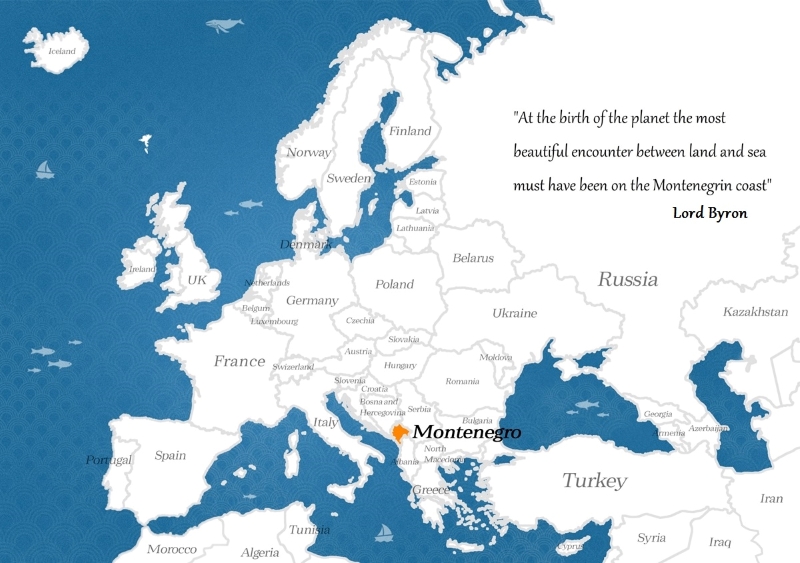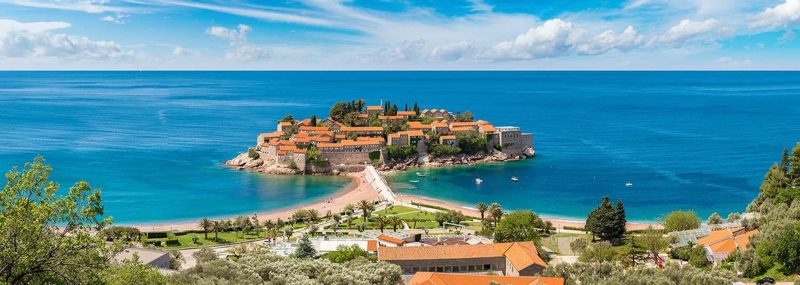About Montenegro
Montenegro is a Mediterranean country in the Balkan Peninsula, at the very heart of Europe.
Montenegro borders Italy (on the Adriatic), Serbia and Kosovo (to the east), Bosnia and Herzegovina (to the north), Albania (to the south) and Croatia (to the west). It covers 13.812 square kilometres and has population slightly over 650.000 (not even million). The capital city is Podgorica – 1857 085 inhabitants. Montenegro has 24 municipalities. The official language is Montenegrin (identical to Serbian, Croatian and Bosnian) and the official currency is euro. Time zone: GMT +1. The political system of Montenegro is parliamentary democracy.

Despite its turbulent history, Montenegro is established as a multi-ethnic country in which all the ethnic groups have the same rights. Montenegrins are very hospitable people and very proud of their history and culture.
For much of the 20th century Montenegro was a part of Yugoslavia, and from 2003 to 2006 it was a component of the federated union of Serbia and Montenegro. Montenegro declared its independence from Serbia in 2006, introduced significant privatization, and adopted the euro despite not being a member of the eurozone. Montenegro has been a NATO member state since 2017. Montenegro is the first country to join the EU. The negotiations between Montenegro and the EU began officially on 29th June 2012.
Montenegro is a signatory to 6 multilateral free trade agreements: Free Trade Agreement with the EU, European Free Trade Association (EFTA), Central European Free Trade Agreement (CEFTA), Free Trade Agreement with Russia, Free Trade Agreement with Ukraine and Free Trade Agreement with Turkey and it is a member of numerous international organisations.
The World Bank classifies Montenegro as one of the fastest-growing Balkan economies, and the nation is quickly establishing itself as a key strategic destination for some of the world’s most important industries.

Climate
The climate is warm and moderate. Lower regions close to the Adriatic coast have Mediterranean climate with dry and hot summers and pleasant, rainy winters. The central and northern area have continental climate where temperatures vary with greater difference.
Nature and attractions
As it is small in size it is ideal for tourism considering the fact that in a single day you may enjoy beautiful beaches and amazing mountain landscapes. Montenegro is a land of natural rarities. It has one of two European primeval forests, the southernmost fjord in the world, and the largest lake in the Balkans, a river with the deepest canyon in Europe and second in the world. There are 40 lakes in it and its rivers have remained the cleanest in Europe.
However, what attracts tourists most are Montenegrin beaches, which are considered the most beautiful in Europe. These beaches stretch along the entire coast of Montenegro, from Albanian to Croatian border. National parks, five of them in Montenegro, represent unique natural attractions.
*National park Biogradska gora – one of the last primeval forests in Europe.
*National park Durmitor – rafting down the Tara canyon, the deepest canyon in Europe, is one of the most popular activities in Montenegro.
*National park Lovćen – a wonderful mountain with natural, cultural and historic motifs.
*National park Lake Skadar – the largest lake in the Balkans and a habitat of varied flora and fauna.
* Prokletije or Balkan Alps – the youngest national park in Montenegro (since 2009) and a unique mountain range which has a large number of natural beauties. It is one the least explored and a rather mysterious area of Montenegro.
Transport
The road network is 7,835km long (5,436 of asphalt roads). Montenegro has two international airports – in Podgorica and Tivat – which transport 2,454,524 (2018) passengers a year in 14,731 (2018) flights. There are four harbours: Bar, Kotor, Zelenika and Tivat, a ferry boat line Bar-Bari-Bar and Bar-Ancona- Bar as well as a railway line Bar-Podgorica-Belgrade-Budapest.
